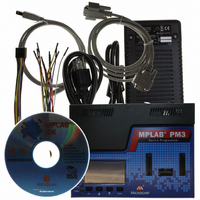DV007004 Microchip Technology, DV007004 Datasheet - Page 117

DV007004
Manufacturer Part Number
DV007004
Description
PROGRAMMER UNIVERSAL PM3
Manufacturer
Microchip Technology
Series
MPLAB® PM3r
Type
Universalr
Specifications of DV007004
Contents
MPLAB PM3 Programming Unit, Cables, Power Supply and IDE
Positions/sockets
1
Ic Product Type
Programmer, Universal
Supported Families
PICmicro, DsPIC30F
Kit Contents
LCD, ICSP Support, 40-pin Socket, Digital/Multimedia Card Slot
Rohs Compliant
NA
Lead Free Status / RoHS Status
Lead free / RoHS Compliant
For Use With/related Products
Microchip's PICmicro devices including dsPIC30F
Lead Free Status / Rohs Status
Lead free / RoHS Compliant
For Use With
PICmicro And DsPIC30F DSC Devices
Lead Free Status / RoHS Status
Lead free / RoHS Compliant, Lead free / RoHS Compliant
Available stocks
Company
Part Number
Manufacturer
Quantity
Price
Company:
Part Number:
DV007004
Manufacturer:
Microchip Technology
Quantity:
135
Company:
Part Number:
DV007004
Manufacturer:
MICROCHIP
Quantity:
12 000
Company:
Part Number:
DV007004 (MPLAB PM3)
Manufacturer:
MICROCHIP
Quantity:
12 000
© 2006 Microchip Technology Inc.
2. Make sure that a COM port is properly set up exclusively for use by the program-
3. Some system errors are caused by driver and hardware incompatibility.
4. Try connecting the programmer to a different serial port. If your PC has a 25-pin
5. Check that the device is plugged into the demo board/target application correctly;
For more information, see Section B.5.2 “Advanced Serial Communications Help”.
B.5.1.3
1. Make sure you used the MPLAB IDE supplied USB driver for MPLAB ICD 2.
2. Make sure USB is selected on the Programmer>Settings Communications tab.
B.5.2
Here are some areas that can cause problems:
• Modem Interaction
• Problems with a Serial Mouse
• Interrupt Conflicts
• Third Party Communications Drivers
• Manually Setting Up The Port
B.5.2.1
The programmers cannot be on the same communications port or the same interrupt
as a modem. You can try disabling the modem in software, moving one or the other to
a different communications port or removing the modem.
B.5.2.2
If you have a serial mouse, make sure you are not accidentally specifying that
communications port as your programmer port.
B.5.2.3
Make sure that your system has no interrupt conflicts. That is, make sure that only one
device is using each interrupt.
On Windows 98/ME, select Settings>Control Panel from the Start menu. Select
System and click on the Device Manager tab. Expand the Ports selection and make
sure there are no conflict indicators.
On Windows NT/2000/XP, select Settings>Control Panel from the Start menu. Select
System and double click on Ports. Click on a COM port from the list and then click
Settings. In the Settings dialog, click Advanced. Make sure there are no IRQ conflicts.
be able to install the proper driver.
If the Windows OS picked a USB driver, MPLAB ICD 2 will not work and you will not
mer. Check the resources to ensure they are operating properly and that there
are no conflicts with other devices. This commonly happens when you have
another device that is improperly configured. Consult your Windows manual or
other reference literature. You can try removing, reconfiguring or disabling the
conflicting device, but do so only if you are familiar with those procedures.
serial port, you will need a 25-to-9 serial port adapter.
e.g., all pins are plugged into the socket and the device is correctly oriented.
USB COMMUNICATIONS
Advanced Serial Communications Help
MODEM INTERACTION
PROBLEMS WITH A SERIAL MOUSE
INTERRUPT CONFLICTS
CAUTION
DS51464C-page 111












